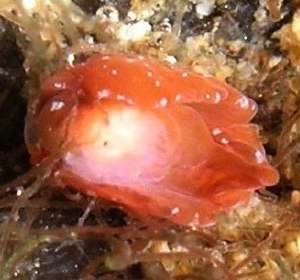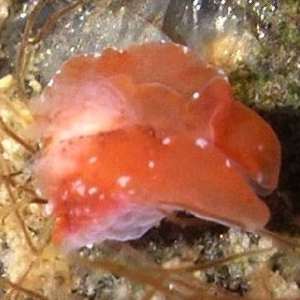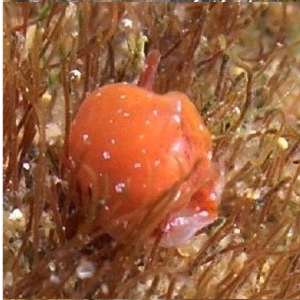

Siphopteron sp. 5
Order: CEPHALASPIDEA
Superfamily: PHILINOIDEA
Family: Gastropteridae
PHOTO
In algal patches and on sand at Casuarina Beach and Watsons Bay, Lizard Island, Queensland, Australia. November - December 2003. From 0.5 to 10m depth. Photos of two colour variants. Body length 3-5 mm (adults). Photos: Nils Anthes
Authorship detailsRudman, W.B., 2004 (January 12) Siphopteron sp. 5 [In] Sea Slug Forum. Australian Museum, Sydney. Available from http://www.seaslugforum.net/find/siphsp5
Related messages
Re: Siphopteron with eggs from northern N.S.W.
March 14, 2005
From: Denis Riek

Dear Bill,
Thanks for your reply [#13294], your help is much appreciated. Here is a better shot of Siphopteron sp. 5 with eggs. As you stated the eggs were in a clear jelly sac approx. 2 mm diameter and attached by a mucous thread.
The common estuary fish Microcanthus strigatus or "stripey" find these slugs very edible. Found three under one rock and two were gone in a flash.
Locality: Brunswick River, N.S.W., Australia. Depth: 2 metres. Length: 4-5 mm. 11 March 2005. Under rock on rock wall. Photographer: Denis Riek
Regards,
Denis
denisriek@hotmail
Riek, D.W., 2005 (Mar 14) Re: Siphopteron with eggs from northern N.S.W.. [Message in] Sea Slug Forum. Australian Museum, Sydney. Available from http://www.seaslugforum.net/find/13327Thanks Denis,
I wondered from your earlier photo whether this animal had a pair of pointed 'tails' but from this photo we can see that the central part of the posterior foot is transparent and was also obscured by the partially extruded egg mass. Curious and hungry fish can be a pain when turning rocks, coral slabs etc. and are certainly a lesson in how dangerous it is for many sea slugs to be 'out and about' in daylight.
Best wishes,
Bill Rudman
Siphopteron with eggs from northern N.S.W.
March 8, 2005
From: Denis Riek

Dear Bill
This is the first example of this family that I have found. It was under a rock in very shallow water and if not for the bright colour I would never have seen it.I had to photograph it at home and when I looked at the shots some have what appears to eggs being carried at the rear and under the flaps.
Locality: Brunswick River, N.S.W. Australia. Depth: 1.5 metres. Length: 3mm. 03 March 2005. Under rock in shallow water, high tide. Photographer: Denis Riek
Sorry the images aren't clearer but it was just too small.
Regards
Denis.
denisriek@hotmail.com


Dear Denis,
I am not sure whether this is just a colour form of the species in your other message [#13295], which I identified as Siphopteron sp. 5. That species certainly has quite a colour variation including animals without white patches. It ceratinly looks as though your animal is carrying eggs. Perhaps it is in the process of laying them as in the few cases of egg laying we know about, the eggs are deposited in a jelly filled sac, either attached by a mucous thread to the substrate, or attached along on side to the substrate.
Best wishes,
Bill Rudman
Siphopteron sp. 5 from northern N.S.W.
March 8, 2005
From: Denis Riek

Dear Bill
Here are some shots of another species of Gastropteridae from the Brunswick River that I can't identify. This was even smaller than the one in my previous message [#13294]]. It also appears to be carrying eggs but it is so small I can't tell.What do you think?
Locality: Brunswick River, N.S.W. Australia. Depth: 1.5 metres, high tide. 3 mm, 4 March, 2005. Under rock, on rock wall. Photo: Denis Riek.
Regards
Denis.
denisriek@hotmail.com


Dear Denis,
This is almost certainly the animal I am calling Siphopteron sp. 5. I can't see enough to be sure, but I suspect what you can see in this animal are the gills.
Best wishes,
Bill Rudman
Colour variation in Siphopteron sp. 5
January 19, 2004
From: Nils Anthes

Dear Bill,
Thanks for your comments on my earlier message. In this message I include some more pictures on the colour variation we found in Siphopteron sp. 5. As I said in my accompanying message concerning Siphopteron quadrispinosum, we unfortunately had no success in finding what this species ate.
Concerning colour variation, the more or less purely red colour variant seems to be most common around Lizard Island [Nth Queensland], followed by the brown ones with white and yellow spots. We found intermediate colour types only occasionally, suggesting that there is a not a totally free combination of the different colour types. Mixed copulations, however, can be regularly seen in the field.
Best wishes
Nils
anthes@uni-muenster.de



Dear Nils,
I am glad you saw these animals mating and in large numbers. If these animals had been collected in ones or twos it would have been quite easy to believe that you had 2 or 3 distinct species. A very instructive lesson
Best wishes
Bill Rudman
Siphopteron sp. 5 from Botany Bay
January 16, 2004
From: Bill Rudman


After posting Nils Anthes' message of the very variably coloured Siphopteron sp. 5,, I realised I had a record of what is almost certainly the same species from Sydney, New South Wales, certainly a lot further south than Nils' record from the Great Barrier Reef.
• Quibray Bay, Botany Bay, Sydney, New South Wales, Australia. On Sargassum, 27 June 1981. Coll: B. Brandley. 3 animals - 6,4,5mm long alive. AM C130162. Photo: Bill Rudman
The parapodia & visceral hump is dark brown with scattered white or translucent clear patches. The edge of the parapodia have many opaque white patches. The headshield is translucent greyish with some brown patching & mottling. The gills are black.
In the photographed specimen the parapodia have distinctly reddish brown patches. There are a pair of short white triangular papillae on the posterior edge of visceral hump. They can swim when disturbed.
Best wishes
Bill Rudman
Siphopteron sp. 5 from Lizard Is
January 14, 2004
From: Nils Anthes


Dear Bill,
This message includes 2 pictures of another Siphopteron species. We found it rather abundant in November and December 2003 in algal patches and on sand at Casuarina Beach and Watsons Bay, Lizard Island (Queensland, Australia) ranging from 0.5 to 10m depth. They show a considerable variation in colouration, from purely red to dark brown animals that show various amounts of white and orange spots. All colour-morphs co-occur and mate in mixed pairs in the field, so there is no reason to assume they are different species. Body length 3-5 mm (adults). The very red animals very much resemble Gastropteron sp. 2, only they have a clear ridge in the siphon that is lacking in G. rubrum. Maybe this is just another example of convergence in colour patterns between Siphopteron and Gastropteron (see message about yellow Siphopteron.
Kind regards
Nils
anthes@uni-muenster.de
Anthes, N., 2004 (Jan 14) Siphopteron sp. 5 from Lizard Is. [Message in] Sea Slug Forum. Australian Museum, Sydney. Available from http://www.seaslugforum.net/find/11845Dear Nils
Thanks for another interesting observation. As you may have noticed I am often saying we don't know enough about colour variability in a species so the fact that this species ranges in colour from plain red to brown with white spots will make it even more important to work with large populations before describing new species.
As I asked with your yellow Siphopteron message, if you have any photos showing intermediate colour patterns they would be very welcome. Concerning convergence in colour pattern. For their to be any biological significance both species would need to live together or have lived together when they evolved their similar colour pattern.
Best wishes
Bill Rudman
